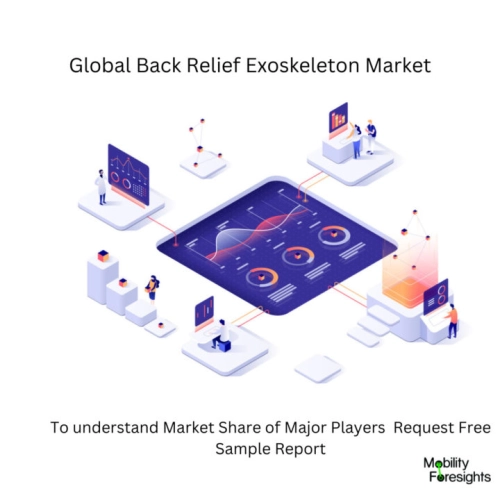
- Get in Touch with Us

Last Updated: Apr 25, 2025 | Study Period:
A wearable device called a back relief exoskeleton is made to support the lower back and lessen strain on it. In order to adequately distribute weight and pressure, it normally consists of a frame that fits around the lower back and hips, coupled with movable straps and support padding.
The lower back's muscles and joints receive external support from the exoskeleton, which lessens the strain on the spine and aids in preventing damage or strain. Those who hold jobs that demand heavy lifting, frequent bending or twisting, or extended periods of standing or sitting may find it very beneficial.
To increase their effectiveness, certain back relief exoskeletons also use cutting-edge technologies including sensors and actuators. For instance, some designs may include sensors to recognise when the wearer is bending or lifting, at which point they may add more lower back support as necessary.
Ultimately, a back relief exoskeleton can be a useful tool for those who regularly deal with back pain or discomfort, as well as for workers who want to avoid accidents and enhance their comfort and productivity at work.

Global back relief exoskeleton market accounted for $XX Billion in 2022 and is anticipated to reach $XX Billion by 2030, registering a CAGR of XX% from 2023 to 2030.
LLC and Laevo are two companies that have recently launched back relief exoskeletons. HeroWear LLC announced the launch of Apex 2, the latest version of its back-assist exosuit.
The Apex 2 exosuit is designed to alleviate worker strain while bending and lifting heavy objects. It is a wearable device that reduces strain and fatigue and reduces the risk of injury for those who frequently bend and lift at work.
Another back support exoskeleton, called Japet.W, was created as an occupational exoskeleton to prevent and treat back pain at the workplace.
It is supposed to lessen the impact on the spine while managing large loads. ReWalk Robotics has also developed wearable robotic exoskeletons that give powered hip and knee motion to enable persons with spinal cord damage (SCI) to stand upright, walk, turn, climb, and descend stairs
| Sl no | Topic |
| 1 | Market Segmentation |
| 2 | Scope of the report |
| 3 | Abbreviations |
| 4 | Research Methodology |
| 5 | Executive Summary |
| 6 | Introduction |
| 7 | Insights from Industry stakeholders |
| 8 | Cost breakdown of Product by sub-components and average profit margin |
| 9 | Disruptive innovation in the Industry |
| 10 | Technology trends in the Industry |
| 11 | Consumer trends in the industry |
| 12 | Recent Production Milestones |
| 13 | Component Manufacturing in US, EU and China |
| 14 | COVID-19 impact on overall market |
| 15 | COVID-19 impact on Production of components |
| 16 | COVID-19 impact on Point of sale |
| 17 | Market Segmentation, Dynamics and Forecast by Geography, 2023-2030 |
| 18 | Market Segmentation, Dynamics and Forecast by Product Type, 2023-2030 |
| 19 | Market Segmentation, Dynamics and Forecast by Application, 2023-2030 |
| 20 | Market Segmentation, Dynamics and Forecast by End use, 2023-2030 |
| 21 | Product installation rate by OEM, 2023 |
| 22 | Incline/Decline in Average B-2-B selling price in past 5 years |
| 23 | Competition from substitute products |
| 24 | Gross margin and average profitability of suppliers |
| 25 | New product development in past 12 months |
| 26 | M&A in past 12 months |
| 27 | Growth strategy of leading players |
| 28 | Market share of vendors, 2023 |
| 29 | Company Profiles |
| 30 | Unmet needs and opportunity for new suppliers |
| 31 | Conclusion |
| 32 | Appendix |